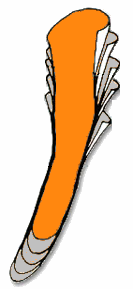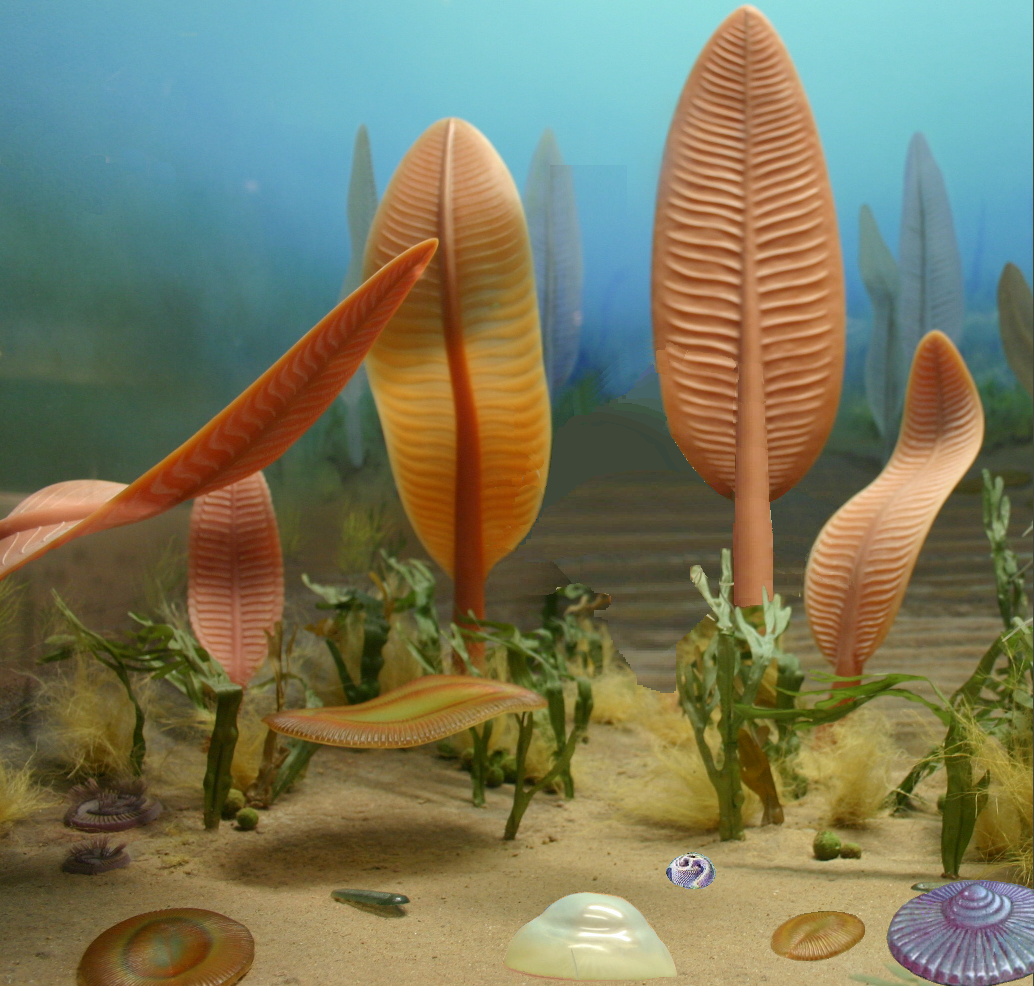|
Namapoikia
''Namapoikia rietoogensis'' is among the earliest known animals to produce a calcareous (probably aragonite) skeleton. Known from the Ediacaran period, before the Cambrian explosion of calcifying animals, the long-lived organism grew up to a metre in diameter and resembles a colonial sponge. It was an encruster, filling vertical fissures in the reefs in which it originally grew. The fossil was first found in the Omkyk Member of the Nama Group from Rietoog in southern Namibia, in association with other calcifying fossils, '' Cloudina'' and ''Namacalathus''. Its mineralogy and accretionary style has been compared with that of the Lophotrochozoans, though its unfamiliar morphology suggests a stem-group or deeper affiliation to this group. It grew in spurts, first emplacing an organic skeleton, then filling this in with aragonite. See also * Ediacaran biota * Namacalathus * Cloudina * List of Ediacaran genera The existence of life, especially that of animals, before the ... [...More Info...] [...Related Items...] OR: [Wikipedia] [Google] [Baidu] |
Nama Group
The Nama Group is a megaregional Vendian to Cambrian group of stratigraphic sequences deposited in the Nama Basin, Nama foreland basin in central and southern Namibia. The Nama Basin is a peripheral foreland basin, and the Nama Group was deposited in two early basins, the Zaris and Witputs, to the north, while the South African Vanrhynsdorp Group was deposited in the southern third. The Nama Group is made of fluvial and shallow-water marine sediments, both siliciclastic and carbonate. La Tinta Group in Argentina is considered equivalent to Nama Group. Description The group extends from the Gariep Belt in the south to outcrops of pre-Damara orogeny, Damara basement (geology), basement in the north.Meert et al., 1997, p.639 Thrombolite-stromatolite reefs in the Nama Group are best developed in the Kuibis Subgroup of the Zaris subbasin, and in the Huns platform of the Witputs subbasin. The Nama Group is a series of interbedded shallow marine carbonates and siliciclastics deposited ... [...More Info...] [...Related Items...] OR: [Wikipedia] [Google] [Baidu] |
Cloudinid
The cloudinids, an early metazoan family containing the genera ''Acuticocloudina'', ''Cloudina'' and ''Conotubus'', lived in the late Ediacaran period about 550 million years ago and became extinct at the base of the Cambrian. They formed millimetre-scale conical fossils consisting of calcareous cones nested within one another; the appearance of the organism itself remains unknown. The name ''Cloudina'' honors the 20th-century geologist and paleontologist Preston Cloud. Cloudinids comprise two genera: ''Cloudina'' itself is mineralized, whereas ''Conotubus'' is at best weakly mineralized, whilst sharing the same "funnel-in-funnel" construction. Cloudinids had a wide geographic range, reflected in the present distribution of localities in which their fossils are found, and are an abundant component of some deposits. They never appear in the same layers as soft-bodied Ediacaran biota, but the fact that some sequences contain cloudinids and Ediacaran biota in alternating layers su ... [...More Info...] [...Related Items...] OR: [Wikipedia] [Google] [Baidu] |
Namacalathus
''Namacalathus'' is a problematic metazoan fossil occurring in the latest Ediacaran. The first, and only described species, ''N. hermanastes'', was first described in 2000 from the Nama Group of central and southern Namibia. Discovery and naming Fossils of ''Namacalathus'' were first discovered in Namibia and were previously described as specimens of '' Cloudina'' in 1990, and were named as a new genus in 2000. Fossils of ''Namacalathus'' have also since been found in Canada, Oman, Paraguay, and Russia. Description A U–Pb zircon age from the fossiliferous rock in Namibia and Oman provides an age for the ''Namacalathus'' zone in the range from 549 to 542 Ma, which corresponds to the Late Ediacaran. Alongside '' Namapoikia'' and '' Cloudina'', these organisms are the oldest known evidence in the fossil record of the emergence of calcified skeletal formation in metazoans, a prominent feature in animals appearing later in the Early Cambrian. Classification Shore ''et a ... [...More Info...] [...Related Items...] OR: [Wikipedia] [Google] [Baidu] |
List Of Ediacaran Genera
The existence of life, especially that of animals, before the Cambrian had long been the subject of debate in paleontology. The apparent suddenness of the Cambrian explosion had no firm explanation, and Charles Darwin himself recognized the challenge it posed for his theory of evolution. While reports of Precambrian organisms have been made since Alexander Murray's 1868 discovery of ''Aspidella'', it wasn't until the discovery of ''Charnia'' in 1956 that considerable evidence of Precambrian life had been presented. The period immediately preceding the Cambrian, the Ediacaran, is now widely accepted of containing animal life. It spans from 635 to 540 million years ago, and covers approximately 2% of Earth's history. Taxonomists have purported a total of 245 described genera from the Ediacaran, 162 of which are accepted as valid. Key * Valid genus - Genera that are accepted by the scientific community * Synonym (taxonomy), Junior synonym - Alternative name for an already existi ... [...More Info...] [...Related Items...] OR: [Wikipedia] [Google] [Baidu] |
Precambrian Africa
The Precambrian ( ; or pre-Cambrian, sometimes abbreviated pC, or Cryptozoic) is the earliest part of Earth's history, set before the current Phanerozoic Eon. The Precambrian is so named because it preceded the Cambrian, the first period of the Phanerozoic Eon, which is named after Cambria, the Latinized name for Wales, where rocks from this age were first studied. The Precambrian accounts for 88% of the Earth's geologic time. The Precambrian is an informal unit of geologic time, subdivided into three eons (Hadean, Archean, Proterozoic) of the geologic time scale. It spans from the formation of Earth about 4.6 billion years ago ( Ga) to the beginning of the Cambrian Period, about million years ago ( Ma), when hard-shelled creatures first appeared in abundance. Overview Relatively little is known about the Precambrian, despite it making up roughly seven-eighths of the Earth's history, and what is known has largely been discovered from the 1960s onwards. The Precambrian fossil ... [...More Info...] [...Related Items...] OR: [Wikipedia] [Google] [Baidu] |
Enigmatic Prehistoric Animal Genera
Enigmatic is an adjective meaning "mysterious" or "puzzling". It may also refer to: * ''Enigmatic'' (album), a 1970 album by Czesław Niemen * '' Enigmatic: Calling'', a 2005 album by Norwegian progressive metal band Pagan's Mind * Enigmatic scale, musical scale used by Verdi and others * "The Enigmatic", a song by Joe Satriani on the album '' Not of This Earth'' See also * Enigmatic leaf turtle, a species of Asian leaf turtle * Enigmatic moray eel, a species found in the Pacific and Indian Oceans * ''Glaresis ''Glaresis'' is a genus of beetles, sometimes called "Enigmatic scarab beetles", in its own family, Glaresidae. It is closely related to, and was formerly included in, the family Scarabaeidae. Although its members occur in arid and sandy areas wo ...'', a genus of beetles sometimes called "enigmatic scarab beetles" * Enigma (other) {{disambig ... [...More Info...] [...Related Items...] OR: [Wikipedia] [Google] [Baidu] |
Ediacaran Life
The Ediacaran (; formerly Vendian) biota is a taxonomic period classification that consists of all life forms that were present on Earth during the Ediacaran Period (). These were enigmatic tubular and frond-shaped, mostly sessile, organisms. Trace fossils of these organisms have been found worldwide, and represent the earliest known complex multicellular organisms. The term "Ediacara biota" has received criticism from some scientists due to its alleged inconsistency, arbitrary exclusion of certain fossils, and inability to be precisely defined. The Ediacaran biota may have undergone evolutionary radiation in a proposed event called the Avalon explosion, . This was after the Earth had thawed from the Cryogenian period's extensive glaciation. This biota largely disappeared with the rapid increase in biodiversity known as the Cambrian explosion. Most of the currently existing body plans of animals first appeared in the fossil record of the Cambrian rather than the Ediacaran. ... [...More Info...] [...Related Items...] OR: [Wikipedia] [Google] [Baidu] |
Ediacaran Biota
The Ediacaran (; formerly Vendian) biota is a taxonomic period classification that consists of all life forms that were present on Earth during the Ediacaran Period (). These were enigmatic tubular and frond-shaped, mostly sessile, organisms. Trace fossils of these organisms have been found worldwide, and represent the earliest known complex multicellular organisms. The term "Ediacara biota" has received criticism from some scientists due to its alleged inconsistency, arbitrary exclusion of certain fossils, and inability to be precisely defined. The Ediacaran biota may have undergone evolutionary radiation in a proposed event called the Avalon explosion, . This was after the Earth had thawed from the Cryogenian period's extensive glaciation. This biota largely disappeared with the rapid increase in biodiversity known as the Cambrian explosion. Most of the currently existing body plans of animals first appeared in the fossil record of the Cambrian rather than the Ediacara ... [...More Info...] [...Related Items...] OR: [Wikipedia] [Google] [Baidu] |
Ediacaran
The Ediacaran ( ) is a geological period of the Neoproterozoic geologic era, Era that spans 96 million years from the end of the Cryogenian Period at 635 Million years ago, Mya to the beginning of the Cambrian Period at 538.8 Mya. It is the last period of the Proterozoic geologic eon, Eon as well as the last of the so-called "Precambrian supereon", before the beginning of the subsequent Cambrian Period marks the start of the Phanerozoic Eon, where recognizable fossil evidence of life becomes common. The Ediacaran Period is named after the Ediacara Hills of South Australia, where trace fossils of a diverse community of previously unrecognized lifeforms (later named the Ediacaran biota) were first discovered by geologist Reg Sprigg in 1946. Its status as an official geological period was ratified in 2004 by the International Union of Geological Sciences (IUGS), making it the first new geological period declared in 120 years. Although the period took namesake from the Ediacara Hills ... [...More Info...] [...Related Items...] OR: [Wikipedia] [Google] [Baidu] |
Calcareous
Calcareous () is an adjective meaning "mostly or partly composed of calcium carbonate", in other words, containing lime (mineral), lime or being chalky. The term is used in a wide variety of Science, scientific disciplines. In zoology ''Calcareous'' is used as an adjectival term applied to anatomical structures which are made primarily of calcium carbonate, in animals such as gastropods, i.e., snails, specifically in relation to such structures as the operculum (gastropod), operculum, the clausilium, and the love dart. The term also applies to the calcium carbonate Test (biology), tests of, often, more-or-less microscopic Foraminifera. Not all tests are calcareous; diatoms and radiolaria have siliceous tests. The molluscs are calcareous organisms, as are the Calcarea, calcareous sponges (Calcarea), that have spicules which are made of calcium carbonate. Additionally, reef-building corals, or Scleractinia, are calcareous organisms that form their rigid skeletal structure th ... [...More Info...] [...Related Items...] OR: [Wikipedia] [Google] [Baidu] |
Namibia
Namibia, officially the Republic of Namibia, is a country on the west coast of Southern Africa. Its borders include the Atlantic Ocean to the west, Angola and Zambia to the north, Botswana to the east and South Africa to the south; in the northeast, approximating a quadripoint, Zimbabwe lies less than 200 metres (660 feet) away along the Zambezi, Zambezi River near Kazungula, Zambia. Namibia's capital and largest city is Windhoek. Namibia is the driest country in sub-Saharan Africa, and has been inhabited since prehistoric times by the Khoekhoe, Khoi, San people, San, Damara people, Damara and Nama people. Around the 14th century, immigration, immigrating Bantu peoples arrived as part of the Bantu expansion. From 1600 the Ovambo people#History, Ovambo formed kingdoms, such as Ondonga and Oukwanyama. In 1884, the German Empire established rule over most of the territory, forming a colony known as German South West Africa. Between 1904 and 1908, German troops waged a punitive ... [...More Info...] [...Related Items...] OR: [Wikipedia] [Google] [Baidu] |








